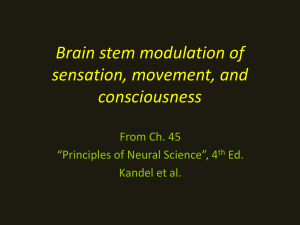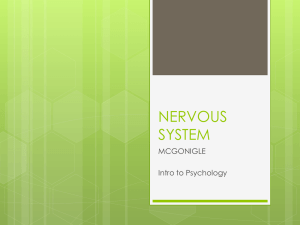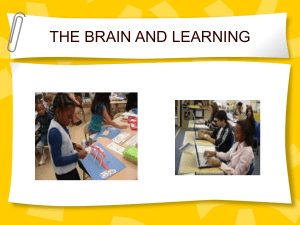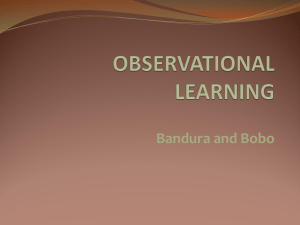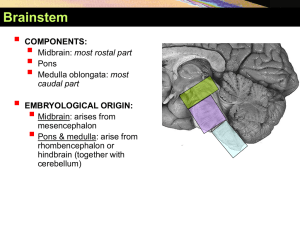Brain_stemCh45
advertisement
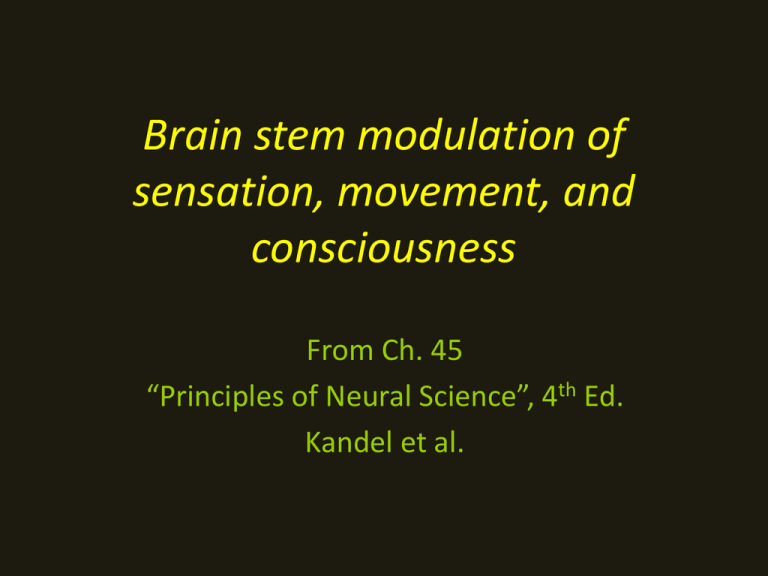
Brain stem modulation of sensation, movement, and consciousness From Ch. 45 “Principles of Neural Science”, 4th Ed. Kandel et al. The brain stem Reticular formation (RF) • RF is a set of interconnected nuclei that are located throughout the brain stem • One of the phylogenetically oldest portions of the brain • Local projections – – Local-circuit interneurons Reflexive and stereotyped behaviors involving face and head: • • • • Long projection systems – – • Chewing, swallowing and vomiting Respiratory activities (coughing, hiccups and sneezing) Cardiovascular responses Brain stem Ascending to cortex Descending to spinal cord Functions of long projections – – – – Pain/ sensory perception Posture Wakefulness/ arousal Filtering incoming stimuli to discriminate irrelevant background stimuli http://www.colorado.edu/intphys/Class/IPH Y3730/image/figure5-29.jpg Reticular formation (RF) • The ascending reticular formation (the reticular activating system) – Responsible for the sleep-wake cycle – Mediates various levels of alertness and consciousness. – Projects to the mid-line group of the thalamus, which also plays a role in wakefulness. From there, information is sent to the cortex. • The descending reticular formation – Involved in posture and equilibrium as well as autonomic nervous system activity. – Involved in sensory and motor modulation. – It receives information from the hypothalamus. RF subsystems • Six neurotransmitter systems – Norepinephrine / noradrenaline (A) • Medulla: A1,A2 • Pons: A5, A6, A7 (A) (B) – Epinephrine / Adrenaline (C) • Medulla: C1,C2 – Dopamine (A8-A17) – Serotonin (B) • Medulla (B1-B3) • Pons and midbrain (B4-B8) – Choline (Ch)/ Acetylcholine – Histamine (E) Noradrenergic/ adrenergic neurons in medulla Dorsal Ventral A1/ C1: near nucleus ambiguus; A2/ C2: Nucleus of the solitary tract/ dorsal motor vagal nucleus; LC (A6): Locus ceruleus A1/ A2 groups project to hypothalamus and controls cardiovascular and endocrine functions A5/A7 are located in the pons and mainly projects to the brain stem and spinal cord where they modulate autonomic reflexes and pain C1 neurons projects to hypothalamus where they modulate cardiovascular and endocrine functions C1 neurons also projects to the spinal cord where they provide tonic excitatory input to vasomotor neurons C2 neurons projects to the parabrachial nucleus providing visceral input Noradrenergic (NA) cell groups • Locus ceruleus – Located in the dorsal wall of the rostral pons – Contains the largest collection of NA cells – Consists of ~ 10.000 neurons – Projects to every major region of the brain and spinal cord – Maintains vigilance and responsiveness to novel/ unexpected stimuli – Influences arousal including sensory perception and muscle tone – Is involved in physiological stress responses Dopaminergic cell groups • Largest DA groups of neurons – – – Substantia nigra (A8, A9) Ventral tegmental area (A10) Other: • • • • • • Dorsal hypothalamus (A11, A13) => spinal cord Tuberoinfundibular hypothalamic neuroendocrine system (A12, A14) Olfactory tubercke (A15) and bulb (A16) Retina (A17) Ascending input to the cerebral cortex and the basal ganglia – – – Nigrostriatal pathway (Globus pallidus, Thalamus) Mesocortical pathway (Prefrontal cortex, ACC) Mesolimbic pathway (Nac, Hipp) Functions – – – – – SN and VTA DA neurons Initiation of motor responses Emotions, thought and memory Reward system/ reinforcement (drug addiction) Regulation of sympathetic preganglionic neurons Eendocrine control Hypothalamic DA neurons Serotonergic cell groups • The raphe nuclei (RN) – Upper/ rostral RN in pons and midbrain • • • – Lower/ posterior RN in medulla • • • • Rostral RN projects to forebrain Posterior RN projects to the brain stem and spinal cord Functions of the rostral RN – – • Raphe magnus (B1) Raphe pallidus (B2) Raphe obscurus (B3) Projections of RN – – • Raphe pontis (B4-B6) Median raphe (B8) Dorsal raphe (B7) Regulation of the sleep-wake cycle Affective behavior Functions of the posterior RN – Regulation of motor tone and pain Cholinergic cell groups • Ch is used by both somatic and autonomic motor neurons • Loci in midbrain – – Pedunculopontine nucleus (PPT), Ch6 Laterodorsal tegmental nucleus (LDT), Ch5 • Projections • • • Reticular formation Thalamus Lateral hypothalamus • Functions • • • Cortical arousal during wakefulness and dreaming (ascending arousal system) Regulation of sleep-wake cycle Enhancement of incoming sensory stimuli Ascending arousal system Histaminegic cell groups • All histaminergic neurons are located in the posterior hypothalamus – Tuberomammillary nucleus (TMN) • • Ventrolaterally Dorsomedially • Projects to all major parts of cerebral cortex and spinal cord • Functions – Regulation of behavioral arousal – Regulation of sleep – Circadian rhythm Reticular formation (RF): again • RF is a set of interconnected nuclei that are located throughout the brain stem • Local projections – – Local-circuit interneurons Reflexive and stereotyped behaviors involving face and head: • • • • Long projection systems – – • Chewing, swallowing and vomiting Respiratory activities (coughing, hiccups and sneezing) Cardiovascular responses Brain stem Ascending to cortex Descending to spinal cord Functions of long projections – – – – Pain/ sensory perception Posture Wakefulness/ arousal Filtering incoming stimuli to discriminate irrelevant background stimuli http://www.colorado.edu/intphys/Class/IPH Y3730/image/figure5-29.jpg Descending projections • Pain modulation – Spinal dorsal horn • • Raphe magnus (serotonergic) in rostral medulla<= opiodergic periaqueductal grey Noradrenergic neurons in pons – Function: descending inhibition of nociceptive transmission • Posture, gait and muscle tone modulation – Medial reticulospinal tracts • • Origins from pontine reticular formation Function: facilitation of spinal motor neurons in legs for postural support and patterned stereotyped movements – Lateral reticulospinal tracts • • Origins from medial medullary reticular formation Function: inhibits cranial and spinal motor neurons => motor tone Ascending arousal system • Two ascending branches – – – • Functions: – – • Thalamus Lateral hypothalamus Multiple neurotransmitter systems Increased arousal: wakefullness and vigilance Increased neuronal responses to sensory stimuli Lesions – Disruption impairs consciousness Electroencephalography • Consciousness – – – – – • Being aware of oneself and one’s place in the enviroment The ability to respond/ orient appropriately to environmental stimuli It is not sufficient to say that consciousness result from the summed cortical activity since the brain stem is crucial Transection of the brain stem below the level of the rostral pons does not affect consciousness Acute transection rostral to inferior colliculus result in coma (unarousability) EEG is important in assessment of wakefulness – – – Reflects firing patterns in the thalamocortical pathway (transmission and burst mode) Wakefulness: low voltage, high frequency, desynchronized patterns Coma: high voltage , low frequency, synchronized patterns as in sleep Burst mode: hyperpolarized neurons respond to brief depolarization with bursts Transmission mode: A depolarized mode where incoming EPSP can drive the neuron to fire in a pattern that reflects the sensory stimuli… single AP produced Brain stem lesions • Respiratory patterns indicates the level of lesion A. Waxing-and-waning pattern with apnea: diffuse forebrain depression due to metabolic encephalopathy e.g. liver failure B. Hyperventilation: injury to mid brain C. Apneusis: injury to rostral pons – breathing halts briefly at full inspiration D. Ataxic breathing: injury to the lower pons or upper medulla – irregular and uneven depth of breathing E. Complete apnea (respiratory arrest): bilateral lesion of the ventrolateral medulla ETC. • Integration of sensory input and motor output occurs in the brain stem as well. For example, the midbrain integrates auditory input and motor responses in the eye. • The brain stem also contains specific pathways which move information from the spinal level up to the brain and other descending pathways from the brain.
